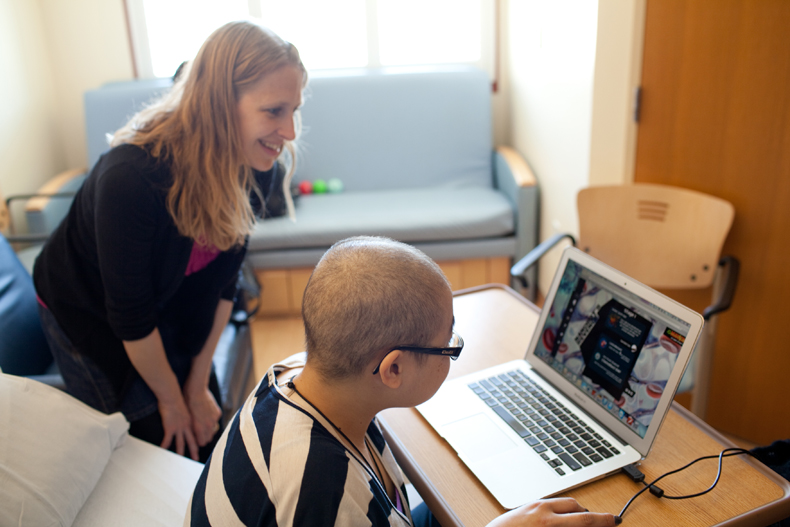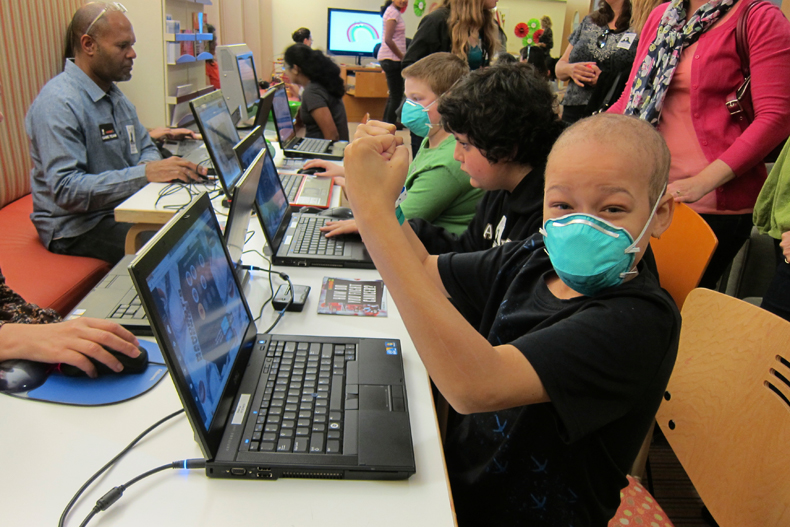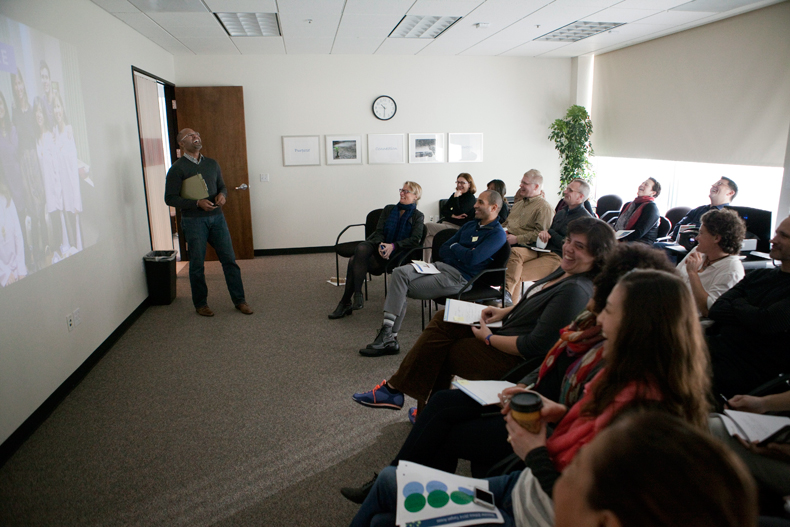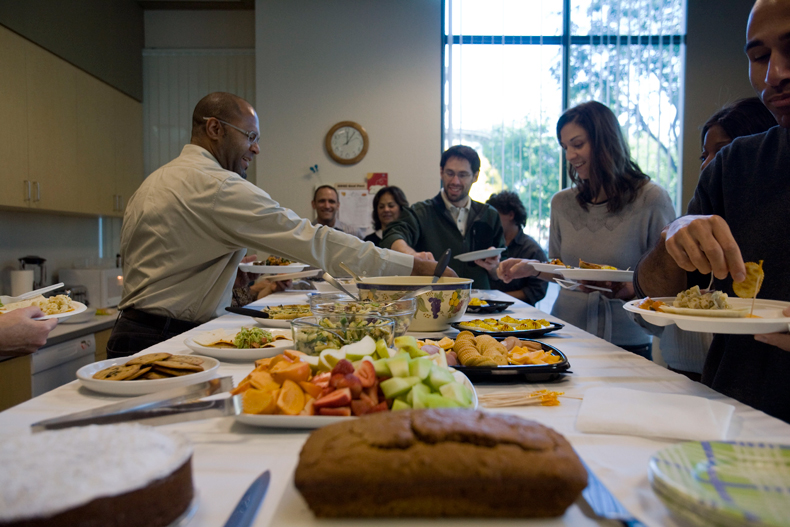Jun 23, 2014 8 Questions With: HopeLab
I was introduced to HopeLab through Nicole Guthrie at TEDWomen 2013 in San Francisco and was very intrigued with their science-driven approach to technology development. HopeLab is a 501c3 nonprofit operating foundation that develops technology-based tools that boost human reslience and improve health and well-being. The company was founded by scientist and philanthropist, Pam Omidyar (wife of Pierre Omidyar, founder of eBay), who experimented with the idea of giving young cancer patients a chance to blast their cancer in a video game to improve their health, realized as Re-Mission. Other products that HopeLab has developed include Zamzee, an activity meter and site to motivate kids to stay active, and Mood Meter, a tool to encourage self awareness and develop emotional intelligence. We had the opportunity to talk to Chris Murchison, Vice President of HopeLab about how he has been able to cultivate a culture of innovation in their workplace environment.How would you describe your role within HopeLab (typical day-to-day and how it has evolved)?
In a broad-brush stroke, I would say that I am lead evangelist for HopeLab’s people and culture, internally and externally. My role includes designing learning and development initiatives, recruiting new staff, coaching team members, sharing insights about our cultivation of organizational culture, and more. That mixture has remained fairly constant over the years. Though my day-to-day schedule varies a great deal, most days include time personally connecting with colleagues to provide support and coaching, as well as time planning and organizing my own project work – preparing for staff gatherings, managing relationships with external partners, job candidates, guests, etc.
When I started at HopeLab, the organization was deep into the research and development of its first product, the Re-Mission video game for young cancer patients. Since then, our work has evolved to focus on the design, development and scientific study of technologies that support human resilience and, ultimately, improve health and well-being. The work is truly leading edge, requiring our staff to be creative, courageous in experimenting with ideas, and rigorous in our standards for design and research. To support this work, the focus of my work was first on building an effective team and creating new routines, practices and systems to support a positive, high-functioning workplace culture. We are now more focused on re-enforcing and deepening those practices, experimenting with ways to become an even more productive, innovative and impactful organization. Our entire team is engaged in this endeavor; we are all stewards of HopeLab’s culture.
How would you describe the organizational culture at HopeLab?
When people visit our office, a frequent impression is that our workplace feels inviting, joyful and family-like but also professional. And it is! We are all inspired by the work we do and the people we do it with, and I believe this naturally creates a culture that is fun, welcoming and high performing.
We’ve been quite intentional in building the culture of the organization. In our external work, we support people’s resilience to help them flourish. We want the same for ourselves. So we apply some of the same concepts to the cultivation of our individual staff and our workplace community. For example, we define resilience as the ability to persevere through adversity, and scientific research indicates that people with a strong sense of purpose, connection and control in their daily lives are better able to respond to life’s challenges in a healthy way. So, we intentionally cultivate opportunities for our staff to feel connected to one another, to have a sense of empowerment and control, and to find meaning in the work they’re doing.
One specific example is our Health and Other Good Stuff (HOGS) program, which focuses on energy-management practices and is inspired by the work of Jim Loehr and Tony Schwartz. The program also applies aspects of our resilience research (purpose, connection and control) to support the health and well-being of our staff and increase our ability to work effectively – and joyfully – as a team.

What qualities do you look for (or work to cultivate) in individuals and in the organization to HopeLab do its unique work?
HopeLab is a values-driven organization, so first and foremost we look for individuals that truly believe in our mission. Next, I would say that curiosity is a core competence for any employee. Curiosity is a portal to other qualities important to us such as integrity, courage, creativity, and attention to beauty.
How does HopeLab’s attention to cultivating culture impact its “bottom line”?
We embrace a “culture as product” philosophy, where our shared values and attention to our collective learning and individual growth are key to both the environment we seek to create at HopeLab and the quality of the work we produce as an organization. Our ability to embody and live our values enhances our ability to achieve our mission – and to do so with greater vitality, commitment, innovation, and impact. For us, “culture as product” refers to our ongoing efforts to share the tools and practices we experiment with in building our culture and what we’re learning along the way. If we can help others create positive, thriving workplace communities by sharing our successes and failures, we’re all for it!
What ideas/individuals have had the most influence on your thinking about creating an effective organization? In what way?
I would name four:
(1) My experience as a Resident Assistant. Learning how to build a community amongst a group of diverse young college students living together was one of the greatest privileges of my youth. And doing this work within the principles and practices of Earlham College, a Quaker institution, gave me invaluable experience stewarding a values-based community.
(2) In my 30s, I participated in The California AIDS Ride, a 7-day, 575-mile trek by bicycle from San Francisco to Los Angeles to raise money for HIV/AIDS services. The event brought together a community of over 2,000 cyclists and volunteers. The first year I rode, I was transformed by the many ways the ride inspired us all. I took the lessons of that first year and, in my second year of participation, pulled together a group of 25 riders – a community within a community – to participate together. We raised over $200,000 and the lessons I learned from leading that team are things I practice today: creating an inspiring vision and shared purpose, generosity, patience, staying focused yet flexible, courage, and empowerment.
(3) I have also learned a great deal from not-so-good work experiences. Each was an opportunity to master new skills, become more resilient and to think through ways to craft a different and more positive experience in the workplace.
(4) Finally, I have learned so much from and with Pat Christen, HopeLab’s President and CEO. Our common interest in creating a resilient and thriving organization, our combined work and life experience, our complementary leadership styles, and her abundant curiosity and willingness to experiment have been major influences on me and my perspectives on organization development.
What are some of the challenges you’ve faced building the team at HopeLab?
One of the biggest challenges is assessing a potential employee’s fit with our culture. We obviously focus attention on this during the recruitment process, but selection decisions don’t always work out as anticipated. Observing and naming problems with new hires and figuring out what to do can be tough. Sometimes the solution is coaching and development, but other times we just need to part ways. Coming to the latter decision is hard, and sometimes we take too long to get there. But in either case, we endeavor to manage the process with the greatest respect, compassion and integrity.
Another challenge we face is change. HopeLab is certainly not unique in this. For us, the evolution of our work from building a game to help young cancer patients fight their disease to research and development of technologies to build human resilience represents many years of evolution. We’ve experienced changes in leadership, strategic direction, organization structure, etc., which can feel disruptive, scary and threatening to some staff. However, successfully navigating change can surface new strengths among individuals and teams and help organizations thrive. As we are learning through our new program work, supporting a sense of purpose, connection and control during times of change enhances resilience for both individuals and organizations.
Where would you like to help take HopeLab in the near/long-term future?
Over the past year, we’ve put ourselves under the microscope to better understand the culture we’ve created at HopeLab and how it affects the work of the organization. In fact, we are finalizing an ethnographic research project examining HopeLab’s organization culture. A researcher connected to the University of Michigan’s Center for Positive Organizations has been “living” with us for the last year, attending meetings and events, interviewing staff, and observing day-to-day routines. I am eager to see the analysis of the study and learn what may be good about our culture, as well as how it can be improved. Our goal is to share what we learn through consultation, publication and other engagements to help other organizations build positive and resilient workspaces. No organization is perfect, and I hope insights from this study will provide a framework and path for our future organization development and for others.
As a kid, what did you aspire to be?
I wanted to be a doctor when I was young and remember feeling very proud announcing that to my West Indian grandmother. I pursued that dream all the way through college but then switched courses. It was a tough decision for me. Ultimately, I determined that I was only 80% convinced that being a physician was right for me and that the medical school culture would fit my personality. Succeeding in medical school requires 110% commitment, so I chose not to enroll and spent a year deciding my next move. I have absolutely no regrets, and the career decisions I have made since then have fulfilled my core interest and purpose in life: to support and be of service to others in the development of their full potential.
Be sure to follow us on Twitter, Instagram, and Facebook for more Imprint content!






